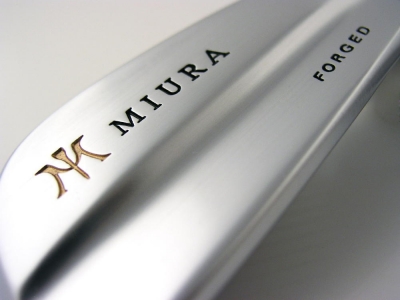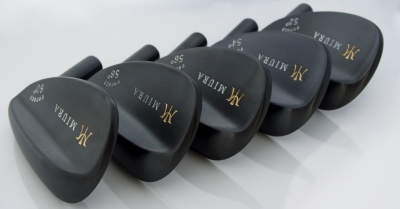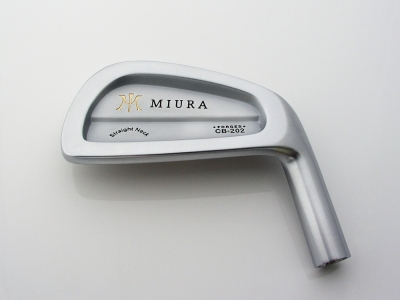By Jeffrey A. Rendall, Images courtesy of Miura Golf
In the age of mass production, sometimes craftsmanship gets lost – especially when you’re talking about the golf industry. Large companies pay top dollar for the computer software to design the most technologically advanced golf clubs ever, and then invest heavily in the machinery to mass-produce them.
Don’t get me wrong, golf clubs have come a long way, and much of their advancement would not have been possible but for the use of computers and machines. Great minds have pushed innovation to the very limits, and as a result, average golfers have access to the same technology that pros enjoy every day. But every now and then, you’ll find an operation where the ‘art’ of the craftsman is still honored.
That’s the inspiration behind 65-year-old Katsuhiro Miura and Miura Golf. Mr. Miura has been crafting golf clubs for over forty-years, and in many ways, continues the same trade techniques and discipline that guided master Samurai sword craftsmen of the Himedji region of Japan, where he resides and works.
Samurai sword craftsmen chiseled and polished the best iron weapons in the world for centuries, then (about a hundred years ago) applied those ancient techniques into a new endeavor that was a little less ‘dangerous’ – making golf clubs. There’s certainly a strong connection between the Japanese warrior tradition and the grand game of golf.
Miura golf products could very well be the best golf clubs you’ve never heard of, simply because they don’t advertise, and many name professionals have used the clubs under different logos. Miura doesn’t pay players to use the clubs, but some still do – you’ll just have to check the public information lists to see who might be sneaking them into their bags.
Bill Holowaty is the Vice President, General Operations for Miura Golf, and describes how ‘handmade’ sets Miura apart from the rest: “Ultimately, what separates Miura Irons from other club makers is the fact that our manufacturing process does not lend itself to mass production. Miura irons are produced using a 14-step process, and include steps which are unique and proprietary to Mr. Miura.”
 |
Holowaty continues, “Perhaps what is most significant is that Mr. Miura still occupies the number one chair on the grinding line.”
It’s true. Mr. Miura still oversees the operation and ensures that every iron head that bears his name is up to his standards. He’s also involved his two sons in the business, and their company staff adheres to the same values set by the head man himself. Miura is one of the world leaders in crafting forged golf clubs, so much so that he’s been said to possess the ‘hands of God.’
But what makes Miura’s forged irons better? Holowaty supplies the answer. “Mr. Miura believes that forged irons allow the skill of the golfer to show, whether professional or amateur, low handicapper or high handicapper. Forged clubs allow players to execute a variety of shots – high, low, curving, or partial with consistency.”
“So-called game improvement or ‘forgiving’ clubs also work, but only if you can square the club at impact. An open face at impact is an open face at impact no matter how big or small the club head is. Mr. Miura’s irons are designed to ‘square at impact’ and that, combined with a forging technique which yields the industry’s tightest grain structure, makes the forged iron the ultimate game improvement club,” Holowaty explained.
For review purposes, I selected the Miura CB 201 irons, which is the company’s best selling iron model. I liked the looks of the heads, with a very traditional forged look, but also because the back of the club looks somewhat like a cavity-back iron. The CB 201 evolved from the legendary Miura CB 1005 version, which was one of Mr. Miura’s best selling models in Japan and also had an international following.
Holowaty says the CB 201 fits the eye of the better player because of the shape and size of the head. True to my impressions, the cavity back gives the perception of more forgiveness – but because of the grain structure in the steel, all Miura irons feel and play very similarly.
How about that steel? “There’s no magic formula for the steel Mr. Miura uses, but his manufacturing process is definitely responsible for the Miura ‘finish’ on the clubs,” Holowaty said. “The tightness of the grain structure does contribute to the appearance of the clubs, but also to the integrity of the clubs.”
Because of the fact they’re forged, and the fact that they’re not ‘oversized’ like so many irons today, you might get the impression that Miura clubs are only for the best players. Not so.
 |
Holowaty explains: “Although the perception is often that Miura irons are geared towards better golfers, all players can play the clubs. It really comes down to which of the Miura models fits your eye the best. Not all golfers would feel confident at set-up with our Tournament Blade model (small size and no offset), but our midsized MC 102 would be popular with those who like the look of a larger head with some offset.”
It’s personal preference. Holowaty says there are 10-15 handicappers who enjoy playing the Miura Blade because that’s what they grew up playing and like the way it looks, and they have scratch players using the MC 102 and CB 301 models, which have much larger profiles. The feel and performance is consistent with all Miura models, so no matter which one you choose, you’ll experience the legendary ‘Miura feel.’
Playing the Miura irons is pure joy. For someone who grew up with small (by today’s standards) headed forged clubs, the look is a perfect fit. The Miura irons are very easy to hit with distances consistent to more ‘forgiving’ club heads, and the looks are second to none.
One thing I noted about using the Miura irons – they seem more durable. Holowaty said it probably has something to do with the manufacturing process, but these club heads don’t seem to get nicked up as easy as other clubs. And generally speaking, forged clubs do last longer.
With clubs of this quality, you’d expect forged irons to make somewhat of a comeback in market share – but they’re also a fair amount more expensive. For his part, Holowaty thinks forged will be ‘back’ in vogue, but it’s hard to say how much. “A few years ago, data showed that forged clubs accounted for only 10% of the golfing market. But the better player still prefers the forged club to a cast club, and we don’t see that changing.”
The internet will make more information available for the discerning buying public, so it’s possible that once people learn that casting doesn’t necessarily mean more forgiving, that people will come to appreciate the once dominant forging process. Forging techniques have also significantly improved over the years, so club makers are able to make larger forged heads with offsets to match.
And when it comes to the ‘feel’ of a forged club, there’s no comparison -- the sound, too. It’s the satisfaction that ‘purity’ brings to the game of golf, a long tradition delivered to every golf shot. If you’re looking for a high-end set of forged, hand-crafted golf irons, we highly recommend that you look for a set of Miura clubs. Consult the Miura website for the means to try them out.
 |
As a bit of an introduction, there are some new offerings from the Miura company, including the CB-202 irons, the Miura Small Blade and the Miura Nobel Black Wedges. The CB-202 irons are the next generation of Miura clubs. The CB-202’s are designed with a thinner top-line and a slightly rounder toe to give the head a sleeker look. There were also minor adjustments made to the sole and leading edge to improve playability – again, personal preference.
The Miura Small Blade was designed to support the golf swing in its simplest form – truly, a work of art in motion. The smaller head (about 15% smaller than the Tournament Blade) and thicker face result in shots becoming more stable. The Nobel Black Wedges are manufactured with an unfinished club face that allows for better ball control and spin characteristics. The wedges are made with a unique ‘spin welding’ process that ensures that bore depths and hosel heights are identical on every Miura made head.
Summing it up, Miura Golf makes the best clubs you’ve never heard of. For those golf purists who are looking for the ultimate combination of craftsmanship and performance, Miura’s a must try – then you’ll know for sure that you’re playing with a piece of art on every golf swing.
Details:
Miura Golf’s North American headquarters is in
Consult the website for dealers near you, or send inquiries to Bill Holowaty, bill@miuragolf.com. Telephone: 604-708-4653. FAX: 604-708-4663.
Toll Free: 1-866-GO-MIURA (466-4872)
| Related Links | Comments on this article? | |
|
Maryland National Golf Club Hollow Creek Golf Club Rocky Gap Resort PB Dye Golf Club in Ijamsville Whiskey Creek Golf Club |
E-mail Jeff Rendall, Editor: jrendall@golftheunitedstates.com |












